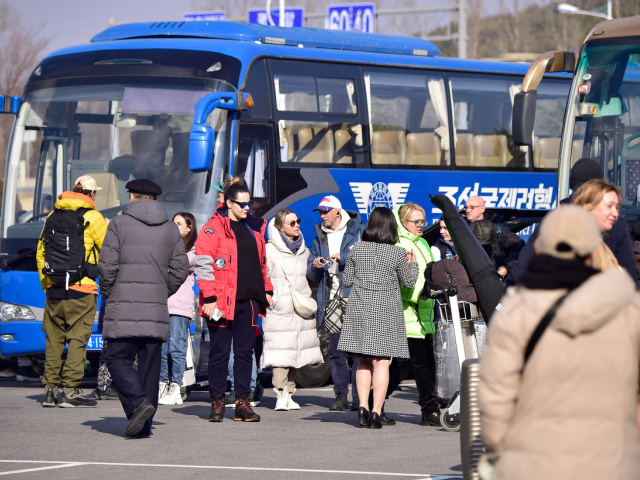Tour companies that specialize in travel to communist North Korea announced this week that they have received word from the repressive government that they will be allowed to bring foreigners in the country in December, the first time Pyongyang has greenlit such travel since the onset of the coronavirus pandemic.
North Korea for decades relied significantly on tourist revenue, generated from both communist-friendly Chinese tourists and curious Western onlookers, to buoy its illicit nuclear program and fund the lavish lives of its communist elite. In 2019, the year before the Wuhan coronavirus pandemic, North Korea generated between $90 million to $150 million on tourism, experts told the Associated Press.
The country shut down travel from abroad entirely in 2020, however, to prevent the novel coronavirus from crossing the Chinese border. North Korean officials maintained for more than two years that they had successfully kept the disease out, only admitting to its first coronavirus case in May 2022. Many outside experts doubted North Korea’s claim to zero coronavirus cases given how porous the border to China along the Yalu River was prior to the lockdowns. Adding to suspicions was a bizarre speech delivered by dictator Kim Jong-un in October 2020 in which he cried and profusely apologized to the North Korean people for unspecified hardships at the time.
Initial news of the return of international travel to North Korea arrived on Wednesday from the company Koryo Tours, which specializes in facilitating travel to North Korea’s communist propaganda sites under the regime’s watchful eye.
“We have received confirmation from our local partner that tourism to Samjiyon and potentially the rest of the country will officially resume in December 2024,” the company said in a statement. “Having waited for over 4 years to make this announcement, Koryo Tours is very excited for the opening of North Korean tourism once again.”
Koryo Tours explained that Samjiyon had “recently been redeveloped” and was believed to be the site most ready to accept mass tourism at the moment. A northern mountain site, Samjiyon offers winter resort-style getaways and is close to the Chinese border.
Koryo warned that “things may be a little more chaotic than usual” for the first available visits but insisted that travelers will “be in safe hands.”
The issue of safety, particularly for Western tourists, in one of the world’s most violent authoritarian states is of great concern given the arbitrary nature of the North Korean justice system. The Kim regime’s abuse of foreigners became an international scandal with the 2017 death of Otto Warmbier, a 22-year-old American arrested while engaging in tourism in the country with Young Pioneer Tours.
Warmbier was allegedly arrested for taking down a communist propaganda poster and was extensively tortured. He was sentenced to 15 years of hard labor in 2016 and, at some point during his abduction, was tortured into a coma and eventually died shortly after he arrived in the United States, the product of successful negotiations by President Donald Trump’s administration.
Young Pioneer Tours announced shortly after the Warmbier incident that it would no longer accept American citizens on its travels.
Kim went on to hold three historic meetings with Trump, culminating with Trump walking out of talks in Hanoi, Vietnam, in 2019 over Kim’s reported intransigence. Prior to the end of talks, however, Kim reportedly emphasized to Trump his desire to turn his destitute communist state into a global tourism hub, home to desirable seaside towns and elite ski resorts.
Koryo Tours and another operator, KTG, which made a similar announcement this week about the restoration of travel, have not stated that they would reject Americans seeking to visit North Korea.
“The only nationalities restricted from travel to North Korea as tourists are citizens of the Republic of Korea,” CNBC noted.
North Korean state media have not informed its public that it would slowly begin allowing tourists from abroad the see the country again. Kim Jong-un made public appearances this week, however, promising massive economic projects to rehabilitate impoverished communities in the country, projects that would require a surge in government revenue. Kim reportedly visited the temporary emergency lodgings of victims of mass flooding in August who were moved to Pyongyang while the disaster was addressed.
“Our confidence in changing today’s disaster to a watershed for transforming regions has become more unwavering based on this unity of the whole society,” Kim reportedly said, promising he would make poor communities more “urbanized, modernized, and civilized.”
The Korean Central News Agency (KCNA), the flagship state news outlet of North Korea, also boasted of a surge in domestic tourism on Thursday, particularly aimed at indoctrinating visitors to propaganda sites.
“In recent one month alone, officials, working people, youth and students of North Hamgyong Province toured the Kuksabong Revolutionary Battle Site, the Sangdansan Revolutionary Battle Site, the Phanjang Temporary Secret Base and other revolutionary battle sites in the province,” KCNA narrated.
“At the Sangdansan Revolutionary Battle Site,” KCNA offered as an example, “they keenly felt Kim Il Sung ‘s love for the soldiers and the anti-Japanese revolutionary fighters’ firm revolutionary outlook on the leader, unyielding faith and ardent patriotism, looking round the site of the headquarters log cabin.”
RELATED — Finding Freedom! North Korean Defector: “I Didn’t Even Know What That Was” Until Long After Escape
Follow Frances Martel on Facebook and Twitter.
